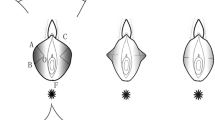Abstract
Introduction
Hoodplasties and labia minora reductions are some of the most requested operative procedures by women distressed with the appearance of their vulvar region. In the majority of cases, a concomitant hoodplasty (HP) is performed to achieve a better aesthetic appearance. Various surgical methods have been described for the removal of excess tissue within the clitoris hood area.
Materials and Method
This study aims to describe a single surgeon’s preference and results in her private practise in 630 patients who underwent labiaplasty mainly because of dissatisfaction with the aesthetic appearance.
Results
Of the 630 labiaplasties performed, 303 had clitoris hood excess, 44% of cases with concomitant HP and in 7.9% of cases only a HP was performed. The study was done between September 2009 and December 2021 and the HP technique was longitudinal excision in 97% of patients and horseshoe excision in 4.95% of them. Surgeries lasted between 30 and 60 min. 98% of the patients claimed an improvement in self-esteem and 96% claimed improvement in sex life post-surgery. No major complications occurred.
Discussion
An isolated labiaplasty technique in patients with hood excess results in disharmony in the area. HP can be considered as a subdivision of a labioplasty. Extended central wedge labia minora resection (V-plasty) is a commonly used procedure in LP operations but can limit the excess clitoris hood resection. Edge labia minora resection can easily be combined with longitudinal excision of the clitoral hood, and when also horizontal clitoris hood excess is present can also be addressed by converting the resection from longitudinal into a horse hose resection. Limitations in the study include lack of use of validated assessments for the satisfaction of aesthetic outcomes and that all the procedures were performed by a single senior surgeon, which can be seen as a strength but also a limitation because of the high risk of bias. Moreover, there was no comparative cohort for the study population. Furthermore, we could not find comparative cohorts in previously reported techniques in the literature either.
Conclusion
Clitoris hood resections should be treated on an individualized approach and adapted according to the excess present. It is important when a patient requests a labiaplasty to always address the clitoris hood during the consultation to avoid unsatisfied patients afterwards. Many patients come just focussed on their labia minora excess and when corrected, realize the clitoris hood excess was also part of the problem.
Level of Evidence III
This journal requires that authors assign a level of evidence to each article. For a full description of these Evidence-Based Medicine ratings, please refer to the Table of Contents or the online Instructions to Authors www.springer.com/00266.





Similar content being viewed by others
References
Triana L, Robledo AM (2015) Aesthetic surgery of female external genitalia. Aesthetic Surg J 35(2):165–177
Hamori CA (2013) Postoperative clitoral hood deformity after labiaplasty. Aesthetic Surg J 33(7):1030–1036
Seo JH, Jo JW, Jo YH (2017) Clinical effectiveness of labia minora reduction surgery. J Cosmet Med. 1(1):52–56
Miklos JR, Moore RD (2008) Labiaplasty of the labia minora: patients’ indications for pursuing surgery. J Sex Med 5(6):1492–1495
Zwier S (2014) “What motivates her”: motivations for considering labial reduction surgery as recounted on women’s online communities and surgeons’ websites. Sexual Med 2(1):16–23
Hamori CA (2014) Aesthetic surgery of the female genitalia: labiaplasty and beyond. Plast Reconstr Surg 134(4):661–673
Kaya AE, Dogan O, Yassa M, Basbug A, Çalışkan E (2018) A novel technique for mapping the vascularity of labia minora prior to labiaplasty: cold light illumination. Geburtshilfe Frauenheilkd 78(08):775–784
Alter GJ (2008) Aesthetic labia minora and clitoral hood reduction using extended central wedge resection. Plast Reconstr Surg 122(6):1780–1789
Zeplin PH (2016) Clitoral hood reduction. Aesthet Surg J 36(7):NP231
Eserdağ S, Anğın AD (2021) Surgical technique and outcomes of inverted-Y plasty procedure in clitoral hoodoplasty operations. J Minim Invasive Gynecol 28(9):1595–1602
Triana L (2019) Aesthetic vaginal plastic surgery: a practical guide. Springer Nature, Switzerland
Turin SY, Kearney A, Placik OJ (2020) Anterior and posterior commissuroplasty: taking labiaplasty to the next level. Aesthetic Surg J 40(10):1111–1121
Ostrzenski A (2013) Selecting aesthetic gynecologic procedures for plastic surgeons: a review of target methodology. Aesthetic Plast Surg 37:256–265
Ostrzenski A (2010) A new, hydrodissection with reverse V-plasty technique for the buried clitoris associated with lichen sclerosus. J Gynecol Surg 26(1):41–48
Ostrzenski A (2013) Clitoral subdermal hoodoplasty for medical indications and aesthetic motives. A new technique. J Reproduct Med. 58(3–4):149–152
Devgan L (2017) The edge-wedge labiaplasty: a novel technique for female genital rejuvenation. Plastic Reconstruct Surgery-Global Open. 5(9S):87–88
Author information
Authors and Affiliations
Corresponding author
Additional information
Publisher's Note
Springer Nature remains neutral with regard to jurisdictional claims in published maps and institutional affiliations.
Rights and permissions
Springer Nature or its licensor (e.g. a society or other partner) holds exclusive rights to this article under a publishing agreement with the author(s) or other rightsholder(s); author self-archiving of the accepted manuscript version of this article is solely governed by the terms of such publishing agreement and applicable law.
About this article
Cite this article
Triana, L., Harini, B.S. & Liscano, E. Hoodplasty: Individualized Approach for Labiaplasties. Aesth Plast Surg (2024). https://doi.org/10.1007/s00266-023-03777-2
Received:
Accepted:
Published:
DOI: https://doi.org/10.1007/s00266-023-03777-2




